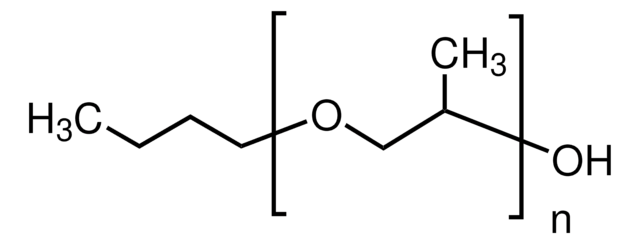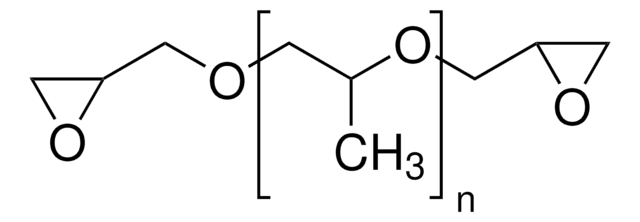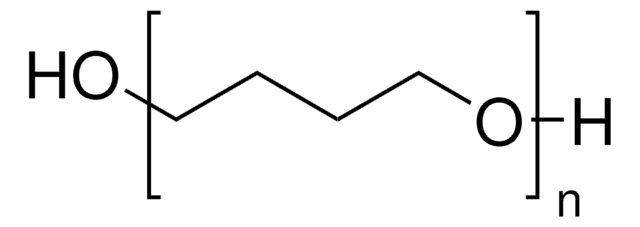202304
Poly(propylene glycol)
average Mn ~425
Synonym(s):
PPG, Poly(propylene oxide)
About This Item
Recommended Products
vapor density
>1 (vs air)
Quality Level
vapor pressure
<0.01 mmHg ( 20 °C)
mol wt
average Mn ~425
contains
130-190 ppm proprietary phenolic antioxidant
refractive index
n20/D 1.447
viscosity
80 cSt(25 °C)(lit.)
hydroxyl value
263 mg KOH/g
solubility
water: miscible (completely)
density
1.004 g/mL at 25 °C
SMILES string
CC(O)CO
InChI
1S/C6H14O3/c1-5(8)4-9-6(2)3-7/h5-8H,3-4H2,1-2H3
InChI key
DUFKCOQISQKSAV-UHFFFAOYSA-N
Looking for similar products? Visit Product Comparison Guide
Application
- As a plasticizer as it does not crystalize, has a low glass transition temperature, and is biocompatible. For example, it can be used in the plasticization of polylactic acid.
- To prepare the aqueous biphasic system for the recovery of ectoine from Halomonas salina cells.
- To study the virtual transition from supramolecular polymer(PPG) toconventional polymer(PPO).
Storage Class Code
10 - Combustible liquids
WGK
WGK 1
Flash Point(F)
445.0 °F - closed cup
Flash Point(C)
229.44 °C - closed cup
Personal Protective Equipment
Regulatory Listings
Regulatory Listings are mainly provided for chemical products. Only limited information can be provided here for non-chemical products. No entry means none of the components are listed. It is the user’s obligation to ensure the safe and legal use of the product.
FSL
Group 4: Flammable liquids
Type 4 petroleums
Hazardous rank III
JAN Code
202304-500G:
202304-250G:
202304-5G:
202304-BULK:
202304-VAR:
Choose from one of the most recent versions:
Already Own This Product?
Find documentation for the products that you have recently purchased in the Document Library.
Customers Also Viewed
Articles
A Review of Mesoporous TiO2 Thin Films
Our team of scientists has experience in all areas of research including Life Science, Material Science, Chemical Synthesis, Chromatography, Analytical and many others.
Contact Technical Service



